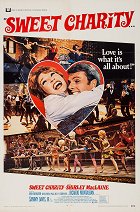Directed by:
Bob FosseCinematography:
Robert SurteesComposer:
Cy ColemanCast:
Shirley MacLaine, John McMartin, Paula Kelly, Barbara Bouchet, Ricardo Montalban, Stubby Kaye, Alan Hewitt, Sammy Davis Jr., Chita Rivera, Bud Cort (more)Plots(1)
Choreographer-turned-director Bob Fosse made his feature film debut with this glitzy screen version of the hit Broadway musical. The star of the show is Charity, a warm-hearted taxi-dancer who longs to "go straight" by marrying a decent guy and settling down to a career as a dental technician. But her trusting nature and dangerously naive outlook on life make the dance hall girl prey for a succession of opportunistic men. Used and abused and finally jilted at the altar, Charity's innocent spirit remains uncrushed, soaring out in the film's collection of lavishly choreographed song and dance routines. (official distributor synopsis)
(more)Reviews (1)
By pure chance, I saw Sweet Charity just a few days after watching Fellini's Nights of Cabiria, and I had the unique opportunity to compare both versions of the same story while they were still fresh in my mind. Usually, when assessing a remake or an original, you end up comparing films that you have seen with a longer time gap, often even several years apart, which inevitably leads to distortion. With knowledge of the work of both filmmakers, I was convinced that Bob Fosse would teach Fellini a lesson on how to make a film attractive to the audience without sacrificing its narrative value. Bob Fosse's background was shaped by Broadway, with its relentless demands for attractiveness and commercial success, so Fosse had perfectly learned how to sell his work in the most appealing packaging. Moreover, he represents an undisputed peak in his genre, and not only in the United States. As for the main role, even here, the American version had all the prerequisites to succeed better because, with all due respect to Giulietta Masina's acting, Shirley MacLaine is in a different league in world cinema. Surprisingly, both gentlemen ultimately came out of this competition undecided. This is partly due to the studio-driven tendencies of American production, which traditionally smooth out the edges of potential controversy, turning a cheap, uneducated prostitute into an honorable dancer, but mostly due to the screenplay, which somehow dilutes the potential of the theatrical source material and the story gets lost. To claim that Bob Fosse only plagiarizes his successful hits in terms of dance and choreography is nonsense because Cabaret and All That Jazz came much later. Rather, it is that Bob Fosse was still searching here, lacking sufficient experience, and the result reflects that. A few dance numbers in the first half of the film are worth seeing, but in the second half, you wouldn't guess that you are watching a legend of musical direction. Overall impression: 55%.
()
Gallery (64)
Photo © Universal Pictures

